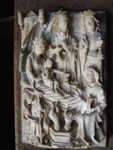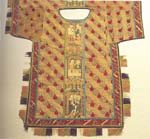England's
Art Exported to the Continent
These arts virtually ceased after the reign of Henry VIII

 Alabaster
carving was one of the primary arts associated with England, site of
the best-known quarries. A form of gypsum, alabaster is relatively soft
when mined, facilitating its carving. It hardens slightly after exposure
to the air and also accepts color and gilt well. Thus it was an ideal
material for complex sculpture for interior decoration of shrines and
altars. The Coronation of the Virgin dates about 1450 and retains
some of its original color and gold highlights.
Alabaster
carving was one of the primary arts associated with England, site of
the best-known quarries. A form of gypsum, alabaster is relatively soft
when mined, facilitating its carving. It hardens slightly after exposure
to the air and also accepts color and gilt well. Thus it was an ideal
material for complex sculpture for interior decoration of shrines and
altars. The Coronation of the Virgin dates about 1450 and retains
some of its original color and gold highlights.
Stained glass was extensively used in England, and extant windows date from the 12th century in Canterbury and Lincoln cathedrals. In the 13th-century-English artists worked in France at the Cathedral of Sens and the Abbey of St.-Yved in Braine. By the fifteenth century, county churches such as East Harling were installing extensive cycles such as Life of the Virgin window.

 Two popular female saints, Katherine and Agnes from a private collection were most probably once in the same window in a church in the vicinity of Norwich . Produced about 1450-60 they exemplify the great boom in church building that accompanied East Anglia ’s economic development of the wool trade during the fifteenth century. English stained glass of the fourteenth and fifteenth centuries is distinguishable for its great delicacy of draftsmanship enhanced by a gamut of silver-stain yellows, here in halos and hair. The practiced skills of the Norwich painters can be seen in the delicate lines circling the eyes and outline the nose, and mouth.
Two popular female saints, Katherine and Agnes from a private collection were most probably once in the same window in a church in the vicinity of Norwich . Produced about 1450-60 they exemplify the great boom in church building that accompanied East Anglia ’s economic development of the wool trade during the fifteenth century. English stained glass of the fourteenth and fifteenth centuries is distinguishable for its great delicacy of draftsmanship enhanced by a gamut of silver-stain yellows, here in halos and hair. The practiced skills of the Norwich painters can be seen in the delicate lines circling the eyes and outline the nose, and mouth.
Embroidery
made in England became so famous that it was simply referred to as Opus
Anglicanum (English work). St. Dunstan's Chasuble, shows embroidery
from two eras 1450s and 1490s, both associated with Canterbury Cathedral. Between
 1499 and 1505 Henry VII commissioned a set of 29 Mass vestments including
copes, a long
cape worn fastened with a elaborate clasp called a morse. The vestments
were bequested to Westminister Abbey for royal ceremonies. In 1520 Henry
VIII used them for ceremonies meeting Francis I on the
Field of the Cloth of Gold outside Calais. Some of the vestments
were publicly burned by Cromwell.
Catholics smuggled others to the Continent, the providence of Stonyhurst
College's sole surviving cope and chasuble.
1499 and 1505 Henry VII commissioned a set of 29 Mass vestments including
copes, a long
cape worn fastened with a elaborate clasp called a morse. The vestments
were bequested to Westminister Abbey for royal ceremonies. In 1520 Henry
VIII used them for ceremonies meeting Francis I on the
Field of the Cloth of Gold outside Calais. Some of the vestments
were publicly burned by Cromwell.
Catholics smuggled others to the Continent, the providence of Stonyhurst
College's sole surviving cope and chasuble.

 A
recusant family, the Towneleys, secretly retained vestments in England.
Vestments made between 1415-35 for Whalley Abbey are now displayed at
Towneley Hall. Whalley
Abbey was a powerful Cistercian monastery founded in Cheshire in
1170 and relocated to Lancashire in 1296. Ruins of the Abbey Church
of 1388 are still extant. The last abbot John Paslew, took part in the
Pilgrimage of Grace a popular uprising in the North against Henry
VIII's ecclesiastical policies and was executed in 1537. (The Towneley
vestments will not travel.)
A
recusant family, the Towneleys, secretly retained vestments in England.
Vestments made between 1415-35 for Whalley Abbey are now displayed at
Towneley Hall. Whalley
Abbey was a powerful Cistercian monastery founded in Cheshire in
1170 and relocated to Lancashire in 1296. Ruins of the Abbey Church
of 1388 are still extant. The last abbot John Paslew, took part in the
Pilgrimage of Grace a popular uprising in the North against Henry
VIII's ecclesiastical policies and was executed in 1537. (The Towneley
vestments will not travel.)
